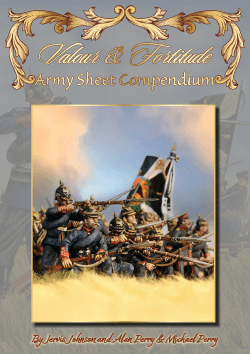
Having trouble viewing the flipbook magazine? View and download it instead!

Welcome to the first compendium to the Valour & Fortitude rules. It was just over a year ago that we published the second edition of Valour & Fortitude in Wargames Illustrated. In the last twelve months we’ve added numerous new army sheets to the game, so that they now cover most of the armies that took part in the Napoleonic wars, as well as armies from several other conflicts. This supplement includes the army sheets we’ve brought out for the American Civil War and Franco-Prussian War, plus two brand-new and never-seen-before army sheets covering the First Carlist War.
The American Civil War was one of the most important conflicts of the 19th Century, and a wargaming period that is only surpassed by Napoleonic battles and World War Two in its popularity. Ideating the representation of post-Napoleonic Wars technology was challenging; luckily for me, John Simmons lent his encyclopaedic knoweldge of the period to the effort. The result is a pair of army sheets that demonstrate the revoutionising impact that new weaponry, like rifled muskets and sophisticated artillery, had on battle methods.
The Franco-Prussian War of 1870-1871 was another fascinating conflict. Even though it was fought only a few years after the American Civil War, it saw the introduction of breech-loading rifles, machine-guns, and modern breech-loading artillery. It was a highly asymmetrical conflict, with the French benefiting from having longer-ranged Chassepot rifles, and the Prussians from their revolutionary Krupp artillery. For V&F, it took a considerable amount of fine-tuning to reflect the benefits of the new types of weaponry without over-stating its impact.
The First Carlist War is a more obscure conflict. It took place from 1833 to 1840, and was fought between the conservative Carlists and the more progressive Isabelinoes. Both sides used uniforms, weapons, and tactics very similar to those used in the Napoleonic Wars, but several factors made the conflict a unique one. The Carlist armies came from quite mountainous regions, and primarily used light infantry tactics. Although they were led by some exceptional commanders, they were hindered by a severe lack of ammunition, and infantry units often went into combat with fewer than half a dozen rounds of ammunition each. The Isabelinoes fielded a more conventional army, and had somewhat less inspired leadership, but benefited from the support of British, French, and Portuguese troops. All in all, it is a colourful and unusual conflict that featured many of the characteristics of the Spanish Civil War fought a century later.
When taken together, the six army sheets included here show how warfare evolved and changed from the Napoleonic period through to the FrancoPrussian War, however, these army sheets form just the tip of the iceberg. If you visit the Perry Miniatures website, you’ll find army sheets for the War of the Triple Alliance, fought in South America in the 1860s, for the American War of Independence (or the Revolutionary War as our American friends call it), and for new Napoleonic armies, such as the Ottomans and Prussian armies of 1806-1807. We’re being helped in this by the sterling efforts of the players that are part of the Valour & Fortitude – Gamers Group page on Facebook. Not only have they provided vital feedback on the army sheets we’ve already put out, but several of them have taken the plunge and are coming up with army sheets of their own. I recommend that you visit the group’s page to find out more.
I’ll finish by saying that you can download the V&F second edition rules, army sheets, and scenarios for free from from wargamesillustrated.net and perry-miniatures.com. One of the benefits Valour & Fortitude being available like this is that I can periodically update the rules and army sheets, fixing any errors that are pointed out to me, and modifying some of the game mechanics to make them easier to understand and use. So, make sure to pop along soon, so you can download the very latest version! The Perry Miniatures website also hosts a growing number of translations of the rules (French, German, and Italian to name but three), as well as a number of play-aids and optional rules files. Last, but far from least: if you have any questions or feedback, please feel free to email them to me at vandf.rules@gmail.com, and I will do my best to get back to you as quickly as possible.
Jervis Johnson, August 2024

